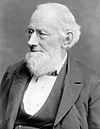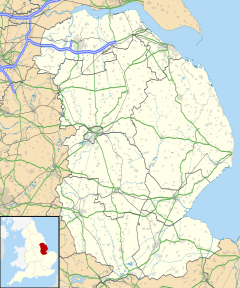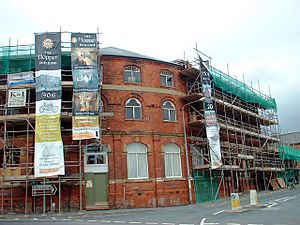Barton-upon-Humber facts for kids
Quick facts for kids Barton-upon-Humber |
|
|---|---|
 Market Place, Barton-upon-Humber |
|
| Population | 11,066 (2011 Census) |
| OS grid reference | TA030221 |
| • London | 150 mi (240 km) S |
| Civil parish |
|
| Unitary authority | |
| Ceremonial county | |
| Region | |
| Country | England |
| Sovereign state | United Kingdom |
| Post town | Barton-upon-Humber |
| Postcode district | DN18 |
| Dialling code | 01652 |
| Police | Humberside |
| Fire | Humberside |
| Ambulance | East Midlands |
| EU Parliament | Yorkshire and the Humber |
| UK Parliament |
|
Barton-upon-Humber (also called Barton) is a town in North Lincolnshire, England. It had about 11,000 people living there in 2011. The town is on the south side of the Humber Estuary, right at the end of the Humber Bridge. It is about 6 miles (10 km) south-west of Kingston upon Hull. Other towns nearby include Scunthorpe and Grimsby.
Contents
Exploring Barton-upon-Humber
Barton is located on the south bank of the Humber Estuary. The famous Humber Bridge ends here. The Viking Way, a long walking path, also starts near the bridge.
Getting Around Barton
The Barton Line train service (which opened in 1849) ends at Barton-on-Humber railway station. This line connects Barton to places like Grimsby and Cleethorpes. The A15 main road goes past the west side of town. It crosses through Beacon Hill. You can also find the A1077 road here, which goes to South Ferriby.
Local buses are run by Stagecoach in Lincolnshire and East Yorkshire. They connect Barton to towns like Cleethorpes, Grimsby, Scunthorpe, and Hull.
Barton's Past: A Look at History
Ancient Times
People have lived in the Barton area for a very long time. Signs like Cropmarks (patterns in fields) and old stone tools called handaxes show that people were here during the Stone Age. This was around 4,000 to 2,500 BCE.
Roman Era Discoveries
No large Roman town has been found in Barton. However, some Roman items have been discovered. In 1828, people found a Roman burial site. In 1967, part of a Roman road was found near a school. Other finds include Roman coins, pottery, and tools. A collection of Roman treasures called the Deepdale Hoard was found nearby in 1979.
Anglo-Saxon Life
An Anglo-Saxon burial ground was found at Castledyke South in 1939. This cemetery was used from the late 400s to the late 600s. Over 200 skeletons were found there. One person even had brain surgery (called trepanning) and survived!
Some historians think the famous Battle of Brunanburh (in AD 937) might have happened near Castledyke South. This was a very important battle in British history. A large fleet of warships came into the Humber led by a Viking king named Olaf Guthfrithsson. King Æthelstan and his army defeated them.
Medieval Times
Barton is mentioned as a town in old documents from 1086. A ferry service to Hull was also recorded in 1086. The oldest house in Barton is 51 Fleetgate. It dates back to 1325. The main manor house in medieval Barton was Tyrwhitt Hall, which is from at least the 1400s.
Historic Churches
Barton-upon-Humber has two old churches: St Peter's and St Mary's. They are very close to each other.
St Peter's is a large church with many Anglo-Saxon parts. It was closed in 1972. Later, the remains of about 2,750 people were moved from the church. These remains are important for studying how diseases developed over time. The church reopened in 2007 for medical research.
St Peter's is older than St Mary's. St Mary's might have started as a small chapel in the market area. It became more important as the town's trade grew in the 1100s and 1200s.
18th and 19th Century Changes
- The Barton Ropery, where ropes were made, opened in 1767.
- The United Reformed Church opened in 1806.
- A Temperance Hall opened in 1843. It later became the Barton-upon-Humber Assembly Rooms in 1906.
- The Police Station and Magistrates Court opened in 1847.
- The Wilderspin National School opened in 1844.
- The first public train arrived in Barton on March 1, 1849.
- The Corn Exchange opened in 1854. It later became a private club.
- The Trinity Methodist Church was built in 1860–1861.
- The Oddfellow's Hall was built in 1864. It was used as Barton's first cinema, a roller skating rink, and a dance hall during World War II.
- The building that is now the Salvation Army Citadel opened as a church in 1867.
- In 1880, Fred Hopper started a bicycle repair business. He soon began making bicycles. His company, Elswick Hopper, became a major bicycle maker.
20th Century Events
- The war memorial lists 165 men from Barton who died in the First World War. It was unveiled in 1921.
- Another 48 men and women who died in the Second World War are also on the memorial.
- The Oxford Picture Theatre opened in 1922. It closed in 1966 and has since been a bingo hall and sports center.
- The Star Theatre opened around 1934 and closed in 1957.
Learning in Barton
Baysgarth School, on Barrow Road, is a school for students aged 11–18. There are also three primary schools: St Peter's Church of England, Castledyke Primary School, and Bowmandale Primary School.
Barton Grammar School used to be on Caistor Road. It opened in 1931. Henry Treece, a famous poet and author, was a teacher there.
Local Industries
From 1850 to 1959, the clay pits near the Humber were used for making tiles and cement. These factories closed in the early 1900s when the clay ran out. The clay pits filled with water and became a nature reserve. This reserve is called Far Ings National Nature Reserve. It was opened by the Lincolnshire Wildlife Trust in 1983.
For 20 years, Barton was home to a very large factory for Kimberly-Clark. It closed in 2013, and over 200 jobs were lost. Wren Kitchens bought the site. They moved their main office there and created many new jobs. In 2019, Wren announced plans for a huge expansion, which would create even more jobs.
Culture and Fun in Barton
Local Events
An event called 'Bike night' has been held every year since 1997. It's a social gathering that celebrates motorcycles. Barton-upon-Humber has also had an annual arts festival since 1998.
Museums to Visit
Since 1981, there has been a local history museum at Baysgarth House. In 2009, the Wilderspin National School museum opened. It teaches about the life and work of Samuel Wilderspin, who was a pioneer in early childhood education. In 2020, a center dedicated to the author Ted Lewis opened.
Places to Eat and Drink
Barton-upon-Humber has at least seven public houses (pubs). These include The Volunteer Arms, The George Hotel, and The Wheatsheaf. Many other pubs have closed over the years. Some have been turned into houses, like The Blue Bell.
Local Media
You can watch regional TV news from BBC Yorkshire and Lincolnshire and ITV Yorkshire. Local radio stations include BBC Radio Humberside and Greatest Hits Radio East Yorkshire & Northern Lincolnshire. Barton FM is a local community radio station. The town is also served by the weekly newspaper, Grimsby Telegraph.
Famous People from Barton
| Name | Image | What they did | Dates | Connection to Barton | Notes |
|---|---|---|---|---|---|
| Nancy Birtwhistle | Chef | Lives in Barton-upon-Humber | Winner of the TV show The Great British Bake Off | ||
| Marjorie Boulton | Author and poet | 1924–2017 | Went to school in Barton-upon-Humber | ||
| Jamie Cann | Politician | 1946–2001 | Born in Barton-upon-Humber | Member of Parliament for Ipswich | |
| Janet E. Courtney | Writer and scholar | 1865–1954 | Born in Barton-upon-Humber | Wrote for the Encyclopædia Britannica | |
| David George Hogarth |  |
Archaeologist | 1862–1927 | Born in Barton-upon-Humber | Was in charge of the Ashmolean Museum in Oxford |
| Thomas Johnson | Botanist and teacher | 1863–1954 | Born in Barton-upon-Humber | A member of the Linnean Society (a group for natural scientists) | |
| Ted Lewis | Author | 1940–1982 | Lived in Barton-upon-Humber after 1945 | His book was made into the film Get Carter | |
| Isaac Pitman |  |
Teacher | 1813–1897 | Lived and taught in Barton-upon-Humber (around 1831–1835) | Invented the Pitman shorthand writing method |
| Christian Sansam | Footballer | b. 1975 | Lives in Barton-upon-Humber | Played football for several teams, including Scunthorpe United | |
| Margaret Sidell | Local councillor | Lives in Barton-upon-Humber | Received an award for helping the local community | ||
| Henry Treece | Poet and writer | 1911–1966 | Lived in Barton-upon-Humber | ||
| Chad Varah | Priest | 1911–2007 | Born in Barton-upon-Humber | Started the Samaritans, a charity that helps people in distress | |
| Samuel Wilderspin |  |
Educator | 1791–1866 | Teacher in Barton-upon-Humber | A pioneer in teaching young children |
| Vanessa Winship | Photographer | b. 1960 | Born in Barton-upon-Humber | Won two World Press Photo Awards |
See also
 In Spanish: Barton-upon-Humber para niños
In Spanish: Barton-upon-Humber para niños




